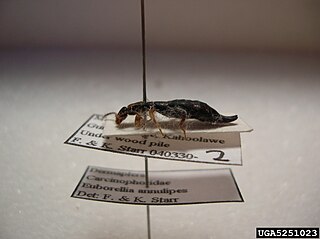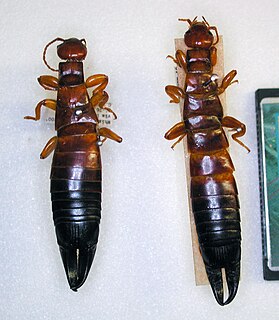
Anisolabididae is a family of earwigs, in the suborder Forficulina and the order Dermaptera. It is one of nine families in the suborder Forficulina, and contains thirty-eight genera spread across thirteen subfamilies.
Aborolabis is a genus of earwigs in the subfamily Anisolabidinae. It was cited by Srivastava in Part 2 of Fauna of India.
Anophthalmolabis is a genus of earwigs, the sole member of the subfamily Anophthalmolabiinae. It was cited by Srivastava in Part 2 of Fauna of India. It was also cited at an earlier date by Steinmann in his publication, The Animal Kingdom in 1986, 1989, 1990, and 1993.
Antisolabis is a genus of earwigs, the sole member of the subfamily Antisolabiinae. It was cited by Srivastava in Part 2 of Fauna of India. It was also cited at an earlier date by Steinmann in his publication, The Animal Kingdom in 1986, 1989, 1990, and 1993.
Apolabis is a genus of earwigs in the subfamily Anisolabidinae. It was cited by Srivastava in Part 2 of Fauna of India.

Brachylabis is a genus of earwigs in the subfamily Brachylabinae. It was cited by Srivastava in Part 2 of Fauna of India. It was also cited at an earlier date by Steinmann in his publication, The Animal Kingdom in 1986, 1989, 1990, and 1993, and by Chen & Ma in Fauna Sinica in 2004.
Carcinophora is a genus of earwigs in the subfamily Anisolabidinae. It was cited by Srivastava in Part 2 of Fauna of India.
Ctenisolabis is a genus of earwigs in the subfamily Brachylabinae. It was cited by Srivastava in Part 2 of Fauna of India. It was also cited at an earlier date by Steinmann in his publication, The Animal Kingdom in 1986, 1989, 1990, and 1993.
Gonolabis is a genus of earwigs in the subfamily Anisolabidinae. It was cited by Srivastava in Part 2 of Fauna of India.
Idolopsalis is a genus of earwigs, the sole member of the subfamily Idolopsalinae. It was cited by Srivastava in Part 2 of Fauna of India. It was also cited at an earlier date by Steinmann in his publication, The Animal Kingdom in 1986, 1989, 1990, and 1993.
Isolaboides is a genus of earwigs, the sole member of the subfamily Isolaboidinae. It was cited by Srivastava in Part 2 of Fauna of India.
Metisolabis is a genus of earwigs in the subfamily Brachylabinae. It was cited by Srivastava in Part 2 of Fauna of India. It was also cited at an earlier date by Steinmann in his publication, The Animal Kingdom in 1986, 1989, 1990, and 1993.
Mongolabis is a genus of earwigs in the subfamily Anisolabidinae. It was cited by Srivastava in Part 2 of Fauna of India.
Parisolabis is a genus of earwigs in the subfamily Parisolabiinae. It was cited by Srivastava in Part 2 of Fauna of India. It was also cited at an earlier date by Steinmann in his publication, The Animal Kingdom in 1986, 1989, 1990, and 1993.
Parisopsalis is a genus of earwigs in the subfamily Parisolabiinae. It was cited by Srivastava in Part 2 of Fauna of India. It was also cited at an earlier date by Steinmann in his publication, The Animal Kingdom in 1986, 1989, 1990, and 1993.
Placolabis is a genus of earwigs in the subfamily Anisolabidinae. It was cited by Srivastava in Part 2 of Fauna of India.
Platylabia is a genus of earwigs, the sole member of the subfamily Platylabiinae. It was cited by Srivastava in Part 2 of Fauna of India. It was also cited at an earlier date by Steinmann in his publication, The Animal Kingdom in 1986, 1989, 1990, and 1993, and by Chen & Ma in Fauna Sinica in 2004.

Titanolabis is a genus of earwigs in the subfamily Anisolabidinae. It was cited by Srivastava in Part 2 of Fauna of India. Among its species is the Australian T. colossea, which at about 5 cm (2.0 in) long is the largest certainly living species of earwig.
Apachyus is a genus of earwigs, in the family Apachyidae. It is one of only two genera in Apachyidae. It has been cited by Henrik Steinmann in his book, The Animal Kingdom, by G. K. Srivastava in Fauna of India, Part II, and by Chen & Ma in Fauna Sinica.



